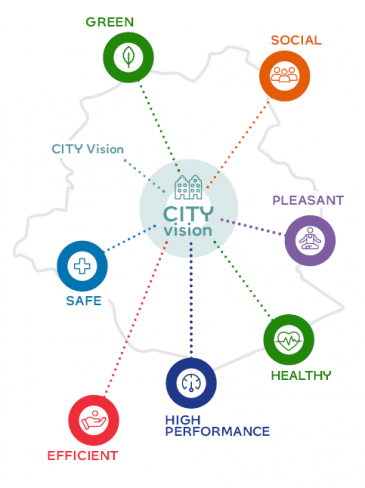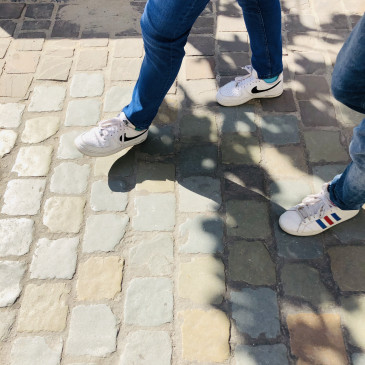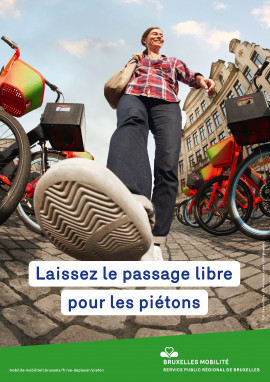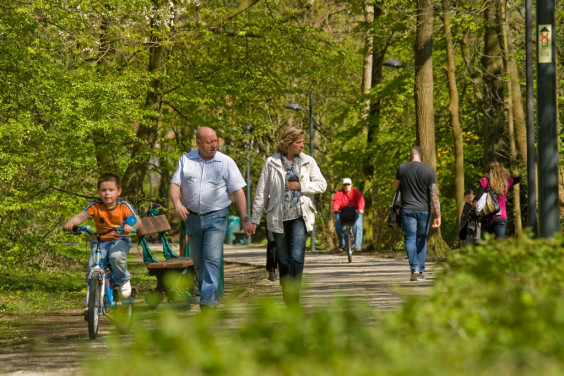
We are all pedestrians! Whether we are a child or a senior citizen, a woman or a man, whether we are shopping, going to school or to work, catching the bus or going to the station, getting to the car or going for a walk: we walk every day for many reasons, especially for short distances. Walking is the most frequently used mode of transport within Brussels.
Walking is perfect in a human-sized city
Walking is at the heart of the urban project developed in the Regional Sustainable Development Plan (2018) and the Good Move regional mobility plan (2020). It is a cornerstone of this city of proximity, projected for Brussels: "the 15-minute city", on a human scale, where everyone can find services and shops close to home. Walking is part of the various dimensions of the City Vision of the Good Move plan as follows:

Social : Walking is the most "democratic" way to travel. You don't need a licence to walk or invest in a car! Furthermore, by continuing to redesign public spaces to make them more accessible and comfortable, people with reduced mobility will also be able to get around on foot with the greatest ease.
Pleasant : When you walk, the city is transformed into a space for encounters and discoveries. You stop to exchange a few words with a neighbour or a friend you meet by chance; you discover, at the corner of a street, a new shop or an urban fresco that has gone unnoticed until now. It is no coincidence that the most attractive cities for tourists are also the most walkable!
Healthy : La marche est le meilleur moyen de lutter contre la sédentarité et de veiller à sa santé mentale et son équilibre psychologique. De plus, elle n’engendre pas de stress comparable à celui qu’on éprouve en conduisant dans les bouchons.
Performant : Walking is the best way to fight against sedentary lifestyle and to take care of your mental health and psychological balance. Moreover, it does not cause stress comparable to that experienced when driving in traffic jams.
Efficient : Walking is the mode of travel that requires the least amount of traffic and parking space, and has many direct and indirect benefits. Investments in walking are very cost-effective and have a positive commercial multiplier effect.
Safe : Walking is, in itself, a safe way to travel. If pedestrians are still too often the victims of road accidents, it is because of inappropriate behaviour, excessive speeds by other road users or inadequate infrastructure.
An efficient, safe and accessible pedestrian network

-
The development of a coherent network of pedestrian routes. For the first time, the Region's new mobility plan provides a map of the pedestrian network in four categories: pedestrian Magistrals (major pedestrian routes that are large and pleasant to walk on or stop on), pedestrian PLUS routes (streets and squares that are the most frequented by pedestrians and have a high quality standard), pedestrian COMFORT routes (connecting routes between pedestrian PLUS routes) and pedestrian NEIGHBOURHOOD routes.
-
The creation of quieter neighbourhoods, relieved of through-traffic, which prioritise the quality and accessibility of public spaces for the benefit of the quality of life. This will benefit walking.
-
The design and development of safe, accessible and comfortable public spaces. In order to improve pedestrian safety, the Region and the municipalities are working to reduce accident-prone areas (ZACA), install speed bumps and provide safe pedestrian crossings. In order to promote walking and increase comfort and accessibility for all, including people with reduced mobility, it is planned to optimise the space available on the road for pedestrians, to install level crossings with podotactile paving stones and to provide non-slip flat surfaces.
- Finally, the Region also pays particular attention to the maintenance of pedestrian infrastructures. With this in mind, in 2020 Brussels Mobility launched a maintenance plan for pavements on regional roads which includes, in addition to occasional corrections, the redevelopment of complete sections of pavement. As part of this work, the pavements are systematically upgraded to universal accessibility standards in accordance with the Cahier de l’accessibilité piétonne and the Plan d’accessibilité de la voirie et de l’espace public (PAVE).

Promotion of walking and advocacy
Campaigns promoting walking
En mai 2021, Bruxelles Mobilité a lancé pour la première fois une campagne de promotion de la marche à l’attention du grand public : Les Pieds. Inspirée des codes propres au lancement de produits de grandes marques américaines, la campagne de Bruxelles Mobilité présentait Les Pieds comme une technologie unique, issue d’un long processus de développement, inspirée du passé, mais pensée pour le futur. Les Pieds sont gratuits, produits localement, 100% naturels, disponibles 24h/24. Ils sont rechargeables partout et permettent une dépense de 67 kcal/km.
Through the contrast between marketing concepts and the obviousness of walking - our natural and ancestral mode of transport - Brussels Mobility wanted to (re)put walking at the centre of attention of the people of Brussels. In recent years, new mobility solutions have appeared in Brussels for short journeys like electric scooters or shared bikes. However, in many ways, walking is still the most efficient, reliable and sustainable way to travel short distances.

After the launch of the campaign - Feet (c), Brussels Mobility wishes to raise awareness of pedestrian inconveniences through a new campaign focusing on the problems linked to the dumping of self-service scooters and bikes.
Indeed, it is clear that a good number of users of micro-mobility devices drop them anywhere in the public space, thus complicating the movements of pedestrians and people with reduced mobility.
Through this campaign, Brussels Mobility reminds these users of the importance of leaving the way clear for pedestrians.
Today, 37% of all trips within Brussels are made on foot. The Good Move plan and the PRDD plan to exceed 50% on foot and by bicycle by 2030. To achieve this objective, it is essential to improve the pedestrian network and the comfort and accessibility of pedestrian routes, which is what Brussels Mobility is working on (see above). However, walking must also be revalued in the eyes of the people of Brussels. This is the objective of the walking campaigns and the pedestrian campaigns that are launched every year.
Walking in school and company mobility plans
It should also be remembered that Brussels Mobility has been supporting the development of walking for many years within the framework of other programmes to promote alternatives to the car. Walking is, in fact, systematically promoted within the framework of the Company Mobility Plans and the School Mobility Plans.
Road safety awareness
Finally, Brussels Mobility regularly raises awareness among motorists about respecting pedestrians and cyclists. Among the themes addressed in the past: respect for traffic lights, traffic rules at crossroads, parking on pedestrian crossings, the dangers of speeding, aggressiveness and courtesy between users... Each of these campaigns is a reminder of some of the rules of the traffic rules.
Some tips
Where to walk ? (article 42 traffic rules)
- On the footpath and in pedestrian-only areas (D9 et D10)


- If there is no practicable pavement or shoulder, pedestrians can use the other parts of the public road, but beware, on the cycle track they must give priority to cyclists who are moving on it.
- If pedestrians have to move on the road, they should walk on the left.
- You should also walk in areas that are reserved for pedestrian traffic (D9 et D10)
- Les zones résidentielles (article 22 bis du code de la route)

- La zone piétonne (article 2.35 code de la route)
: this area is reserved for walking
Before crossing
- Before you start crossing, make sure you can see the traffic and that you are seen by drivers. Always try to make eye contact with drivers. This eye contact will help you to check that he or she has seen you and will let you cross safely.
- If possible, avoid crossing between parked cars, for example. But sometimes in the city it is not possible to do otherwise. Move forward to the height of the doors on the street side of the cars and stop. Again, check that drivers see you (eye contact) before you start crossing. As drivers, avoid parking within 5 metres of pedestrian crossings. It is forbidden and puts them at risk.
- The pedestrian crossing is still the best place to cross: other drivers expect you to cross there. You should use the pedestrian crossing if it is within 20 metres of you.
- You must respect the pedestrian traffic lights.
- The tram always has priority, even in front of a pedestrian crossing, even if the light is green for you. The tram's braking distances are long. To avoid any risk of accidents, it is better to let it pass.
Walking tours

Walking tours are probably the best way to discover the region and soak up the atmosphere of its districts. Museums, nature walks, comics, art nouveau, fashion - there are so many thematic routes that will delight you.
The following websites will also give you ideas for routes:
- Visit Brussels
- Wallonie-Bruxelles Tourisme (WBT)
- Le site de la Forêt de Soignes
- Le portail de la Région bruxelloise
La Promenade Verte
The Promenade Verte is a magnificent walk of over 63 km. It allows pedestrians and cyclists to tour the region and pass through numerous parks and areas of unspoilt nature. The richness of the Promenade Verte lies largely in its astonishing diversity of landscapes.
The Promenade Verte is not just for recreational purposes. It is also designed to make it easier for the people of Brussels to get around the city by taking shortcuts. The route is also designed to facilitate access to public transport.
More information : Bruxelles Environnement - IBGE
Further reading
- Plan régional de mobilité Good Move et sa synthèse
- Good Neighbourhood, Good Network, Good Service et Good Choice
- Plan d’action Sécurité routière
- Plan d’accessibilité de la voirie et de l’espace public (PAVE)
- Guides techniques pour les aménagements piétons
- Charte sur les revêtements piétons (2019)
- walk.brussels (plateforme associative de promotion de la marche) (2021)
- Étude sur les gênes piétonnes dans les rues commerçantes(PDF) (7.36 MB)
